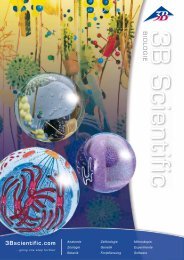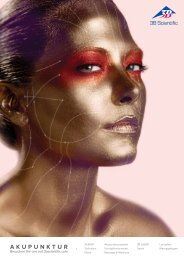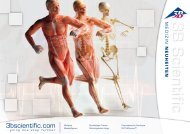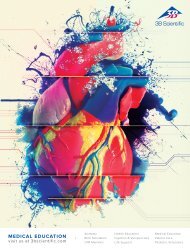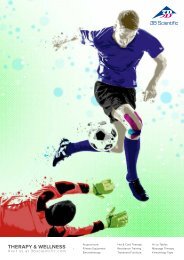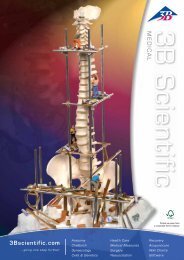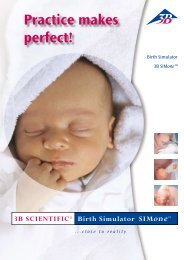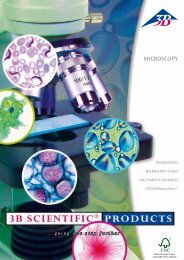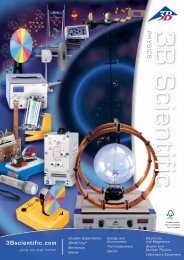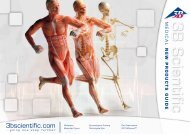3B Scientific - Biology Catalog
3Bscientific.com
3Bscientific.com
You also want an ePaper? Increase the reach of your titles
YUMPU automatically turns print PDFs into web optimized ePapers that Google loves.
Microscope Slides – School Sets<br />
MICROSCOPE SLIDES<br />
Our microscope slides are made under rigorous scientific control. They are the product of long experience combined with the<br />
most up to date techniques. The prerequisite for excellent preparations is good material, well preserved and fixed so that the<br />
finer structures are as life-like as possible. Microtome sections are cut from this material by highly skilled and experienced staff.<br />
Cut to a thickness which will result in slides from which the maximum resolution of the structural components can be obtained.<br />
Particular attention is paid to the staining technique and in each case the selected method for a particular specimen will ensure<br />
the best possible differentiation combined with clear definition and permanency of staining. These prepared microscope slides<br />
are supplied on the best glass with finely ground edges of the size 26x76 mm (1x3") and are mailed in rigid boxes. Most sets are<br />
supplied with comprehensive explanatory brochures. All slides can be purchased either in complete sets and series or individually<br />
at a minimum quantity of 25 mixed slides. We reserve the right to make minor alterations to the advertised sets and compilations.<br />
Delivery time usually between 6 and 8 weeks, but because some micro-compounds are controlled by legal specification, delay in<br />
delivery can be experienced.<br />
!<br />
Excellent workmanship • high-contrast presentation • long life<br />
THE MULTIMEDIA PROGRAM ABCD MICROSCOPIC BIOLOGY<br />
The multimedia system gives a concrete overview of all areas of biology that are of relevance for school<br />
classes, and which can be worked on using a microscope. The main part of the system is made up of four<br />
micropreparations – school sets A, B, C and D – which can be built onto each other. Of course, the individual<br />
series and their components can be used individually in their own right, and added to each the other. To<br />
complete the overview, we recommend using the other media. You can therefore select your favourites from<br />
our programme:<br />
1. Microscope Slides, School Sets A, B, C and D<br />
2. The handbook with texts and diagrams<br />
3. An atlas with reproducible copies and colour photographs of micro-compounds<br />
4. A CD-Rom for interactive learning<br />
Microscopy<br />
School Set A for General <strong>Biology</strong>,<br />
Elementary Set 25 microscope slides.<br />
With depictured accompanying brochure<br />
1(e). Amoeba proteus, nucleus and pseudopodia 2(e). Hydra,<br />
w.m. extended specimen 3(c). Lumbricus, earthworm, typical<br />
t.s. back of clitellum 4(c). Daphnia and Cyclops, small crustaceans<br />
5(d). Musca domestica, house fly, head and mouth<br />
parts w.m. 6(b). Musca domestica, leg with clinging pads (pulvilli)<br />
7(c). Apis mellifica, honey bee, anterior and posterior<br />
wing 8(c). Squamous epithelium, isolated cells from human<br />
mouth 9(d). Striated muscle, l.s. showing striations 10(d).<br />
Compact bone, t.s. special stained for cells and canaliculi<br />
11(d). Human scalp, l.s. of hair follicles 12(c). Human blood<br />
smear, red and white corpuscles 13(d). Bacteria from mouth,<br />
bacilli, cocci, spirilli, spirochaetes 14(c). Diatoms, mixed species<br />
15(c). Spirogyra, with spiral chloroplasts 16(c). Mucor,<br />
mold, w.m. 17(c). Moss stem with leaves w.m. 18(c). Ranunculus,<br />
buttercup, typical dicot root t.s. 19(c). Zea mays, corn,<br />
monocot stem t.s. 20(c). Helianthus, sunflower, dicot stem<br />
t.s., 21(c) Syringa, lilac, leaf t.s. 22(d). Lilium, lily, anthers t.s.<br />
23(d). Lilium, ovary t.s. showing ovules 24(c). Allium cepa,<br />
onion, w.m. of epidermis shows simple plant cells 25(d). Allium<br />
cepa, l.s. of root tips showing cell divisions (mitosis). In<br />
all stages.<br />
9982-1004261<br />
19982-1004262<br />
School Set B for General <strong>Biology</strong>, Supplementary<br />
Set 50 microscope slides.<br />
With depictured accompanying brochure<br />
1(d). Paramaecium 2(c). Euglena, flagellate with eyespot<br />
3(c). Sycon, a marine sponge, t.s. 4(e). Dicrocoelium lanceolatum,<br />
sheep liver fluke, w.m. 5(c). Taenia saginata, tapeworm,<br />
proglottids t.s. 6(d). Trichinella spiralis, l.s. with encysted larvae<br />
7(d). Ascaris, roundworm, t.s. of female 8(b). Araneus, spi<br />
der, leg with comb w.m. 9(d). Araneus, spider, spinneret w.m.<br />
10(d). Apis mellifica, honey bee, mouth parts w.m. 11(b). Apis<br />
mellifica, hind leg of worker w.m. 12(e). Periplaneta, cockroach,<br />
chewing mouth parts w.m. 13(b). Trachea from insect<br />
w.m. 14(b). Spiracle from insect w.m. 15(d). Apis mellifica,<br />
sting and poison sac w.m. 16(b). Pieris, butterfly, portion of<br />
wing with scales w.m. 17(d). Asterias rubens, starfish, arm<br />
(ray). t.s. 18(e). Fibrous connective tissue 19(c). Hyaline cartilage<br />
of mammal, t.s. 20(e). Adipose tissue, stained for fat<br />
21(d). Smooth (involuntary). muscle l.s. and t.s. 22(e). Medullated<br />
nerve fibres, osmic acid fixed material showing Ranvier’s<br />
nodes 23(c). Frog blood smear, showing nucleat ed red corpuscles<br />
24(d). Artery and vein of mammal, t.s. 25(d). Liver of pig,<br />
t.s. 26(c). Small intestine of cat, t.s. 27(c). Lung of cat, t.s.<br />
showing alveoli 28(c). Oscillatoria, a blue green alga 29(e). Spirogyra<br />
in scalariform conjugation 30(c). Psalliota, mushroom,<br />
t.s. of pileus with basidia and spores 31(c). Morchella, morel,<br />
t.s. of fruiting body with asci and spores 32(d). Marchantia,<br />
liver wort, antheridia l.s. 33(d). Marchantia, archegonia l.s.<br />
34(d). Pteridium, braken fern, rhizome t.s. 35(d). Aspidium,<br />
fern, t.s. of leaf with sori 36(e). Elodea, waterweed, stem apex<br />
l.s. with meristematic tissue 37(d). Dahlia, t.s. of tuber with inuline<br />
crystals 38(b). Allium, onion, dry scale with calcium oxalate<br />
crystals 39(d). Py rus, pear, t.s. of fruit showing stone cells<br />
40(c). Zea mays, corn, typical monocot root t.s. 41(c). Tilia,<br />
lime, woody dicot root t.s. 42(c). Solanum tuberosum, potato,<br />
t.s. of tuber with starch 43(c). Aristolochia, birthwort, one year<br />
stem t.s. 44(c). Aristolochia, older stem t.s. shows secondary<br />
growth 45(d). Cucurbita, pumpkin, l.s. of stem with sieve<br />
tubes, and vessels 46(d). Root tip and root hairs 47(c). Tulipa,<br />
tulip, epidermis of leaf with stomata 48(c). Iris, typical monocot<br />
leaf, t.s. 49(c). Sambucus, elderberry, stem showing lenticells,<br />
t.s. 50(e). Triticum, wheat, grain sagittal l.s. with embryo<br />
and endosperm.<br />
84<br />
<strong>3B</strong> <strong>Scientific</strong>® <strong>Biology</strong>




